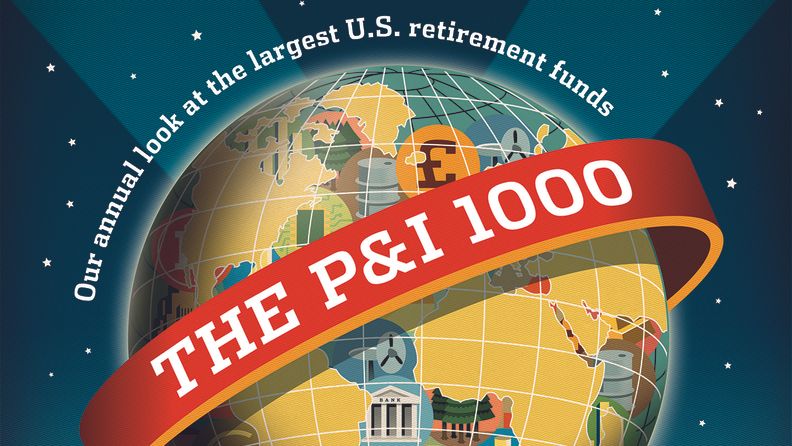Passively managed strategies were among the strongest areas of investment growth among the top 200 DB and DC plans, according to survey data.
DC plans reported higher growth in passive assets than DB plans in the year ended Sept. 30, with passively managed equity assets of $782.3 billion up 35.5% for the year and up 87.9% over five years. Passive fixed-income assets totaled $83.7 billion, an increase of 15.8% for the year and up 53.9% over five years.
For the top 200 DB plans, passive equity assets totaled $1.32 trillion, up 25.6% in the year and up 68.2% over five years. In aggregate, passive fixed income totaled $226.1 billion, an increase of 48.4% for the year and up 148.5% over five years.
The largest defined benefit plan in the U.S. — California Public Employees’ Retirement System, Sacramento, with total assets of $496.8 billion — was responsible for a good portion of the swings in passively and actively managed investments of the top 200 DB plans, survey data provided to P&I showed.
The system decreased investment in actively managed U.S. and international equity, U.S. fixed income and global fixed income by a total of $90.7 billion in the year ended Sept. 30, down 42.7% from the prior year.
CalPERS increased passive management in U.S. and international equity and U.S. fixed income in the system’s $494.5 billion defined benefit plan by $103.5% over the year to $260.4 billion.
CalPERS reported of its $382 billion in equity and fixed-income portfolios, more than 96% was internally managed.
A CalPERS spokeswoman declined to comment on the system’s increase in passive management over the year.
“CalPERS has gone back and forth with a heavy emphasis on passive investment followed by a move back to active management for decades depending on the latest CEO,” said an investment consultant who asked not to be named.
“Wide-bodied pension funds like CalPERS can get some economies of scale leading to lower investment costs and more operational efficiency, particularly if they are managing passive investments internally,” the source said.
“Active management hasn’t worked for most public pension funds over the long term and the tailwinds now are supportive of the move to passive management,” said the source, adding that as more pension funds move to an incentive compensation model, “pension fund investment employees can earn more in other asset classes including alternatives and non-core equity and fixed-income assets.”
Asset classes that also saw growth from the top 200 DB plans in the year ended Sept. 30 included liability-driven investments, which increased 13% for the year and 63.4% over five years to total $158.7 billion; private equity assets totaled $680.8 billion, up 55.3% for the year and 126.6% over five years; and infrastructure investments totaled $57.6 billion as of Sept. 30, up 39.5% for the year and up 196.9% over five years. P&I added a question about investment in China to the survey and found that the top 200 DB plans had $15.4 billion invested in Chinese equity and $400 million in Chinese debt as of Sept 30.
“We expect returns to be lower in the future given market conditions,” said Jonathan Pliner, a New York-based senior director and U.S. head of delegated portfolio management at Willis Towers Watson PLC.
Rising inflation is a concern for many plan sponsors, Mr. Pliner said, noting “the big question coming into 2022 is whether inflation will increase over levels seen last year. The way for pension funds to do well in this environment is diversification into strategies including alternative credit, private equity and real assets.”
The $16.1 billion Arizona Public Safety Personnel Retirement System, Phoenix, is “sitting on cash” thanks to a higher level of voluntary contributions from the employers in the system and investment officers are on the lookout for opportunistic investments, said Michael Townsend, the fund’s administrator.
“We look to invest in different asset classes that others are offloading in 2022 and selling some of our higher-valued assets so we can redeploy the money to new strategies,” Mr. Townsend said, noting asset classes of interest include private equity and credit.
Assets managed by the fund were up 44.3% in the year ended June 30, pushing the fund to the 175th spot in P&I’s ranking from 217 the previous year. It was the second-highest asset growth among all plans in the top 200.
About one-third of asset growth was from contributions and with the balance from a net investment return of 27.8% in the year ended June 30, Mr. Townsend said.
“Given inflation and market conditions, there are a lot of things to take in. We definitely don’t want to try to time the market,” he said.
The three largest retirement funds remained unchanged as they have for many years.
Federal Retirement Thrift Fund Investment Board, Washington, is the largest retirement fund with $774.2 billion in defined contribution plan assets, an increase of 18.9% from Sept. 30, 2020.
CalPERS remained in the second position at $496.8 billion, while assets of the California State Teachers’ Retirement System, West Sacramento, rose 21.1% to $313.9 billion in the year, of which $1.8 billion was in DC assets.
There was some movement among the 10 largest retirement funds in P&I’s universe.
The $161.5 billion Washington State Investment Board, Olympia, inched up to eighth place from ninth with asset growth of 25.3%, knocking Chicago-based The Boeing Co. down to the 10th with assets of $147.2 billion from growth of 10.1% in the year.
State of Wisconsin Investment Board, Madison, moved up to ninth from 11th with assets of $147.9 billion, up 18.8%.






